Criminal Litigation: Analysis of PACE Act Breaches & Legal Issues.
VerifiedAdded on 2023/06/10
|10
|3089
|331
Report
AI Summary
This report provides a comprehensive analysis of a criminal litigation case involving Sheila Smith, focusing on potential breaches of the Police and Criminal Evidence Act 1984 (PACE Act) by police officers and the conduct of her solicitor. The report examines the reasonableness of the police stop and search, adherence to PACE guidelines regarding informing the suspect of their rights, and the admissibility of evidence obtained. It also considers potential violations of the European Convention on Human Rights (ECHR), specifically Article 8, and explores the possibility of suing the police for false imprisonment. Furthermore, the report addresses issues related to Sheila's detention, including the denial of her right to intimation under Section 56, the review of her detention, and the threats made to induce a confession. The solicitor's unprofessional behavior and failure to adequately represent Sheila are also highlighted.
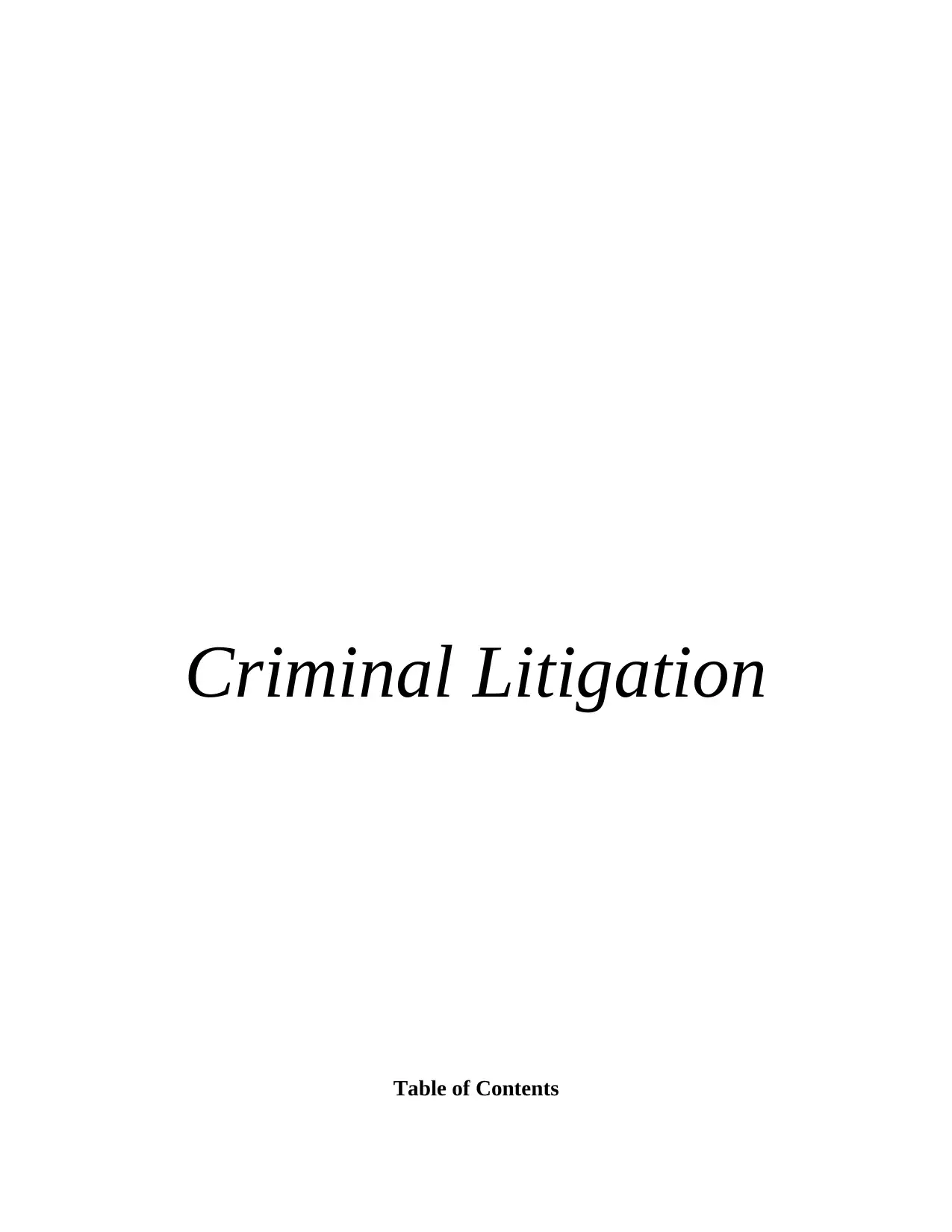
Criminal Litigation
Table of Contents
Table of Contents
Paraphrase This Document
Need a fresh take? Get an instant paraphrase of this document with our AI Paraphraser
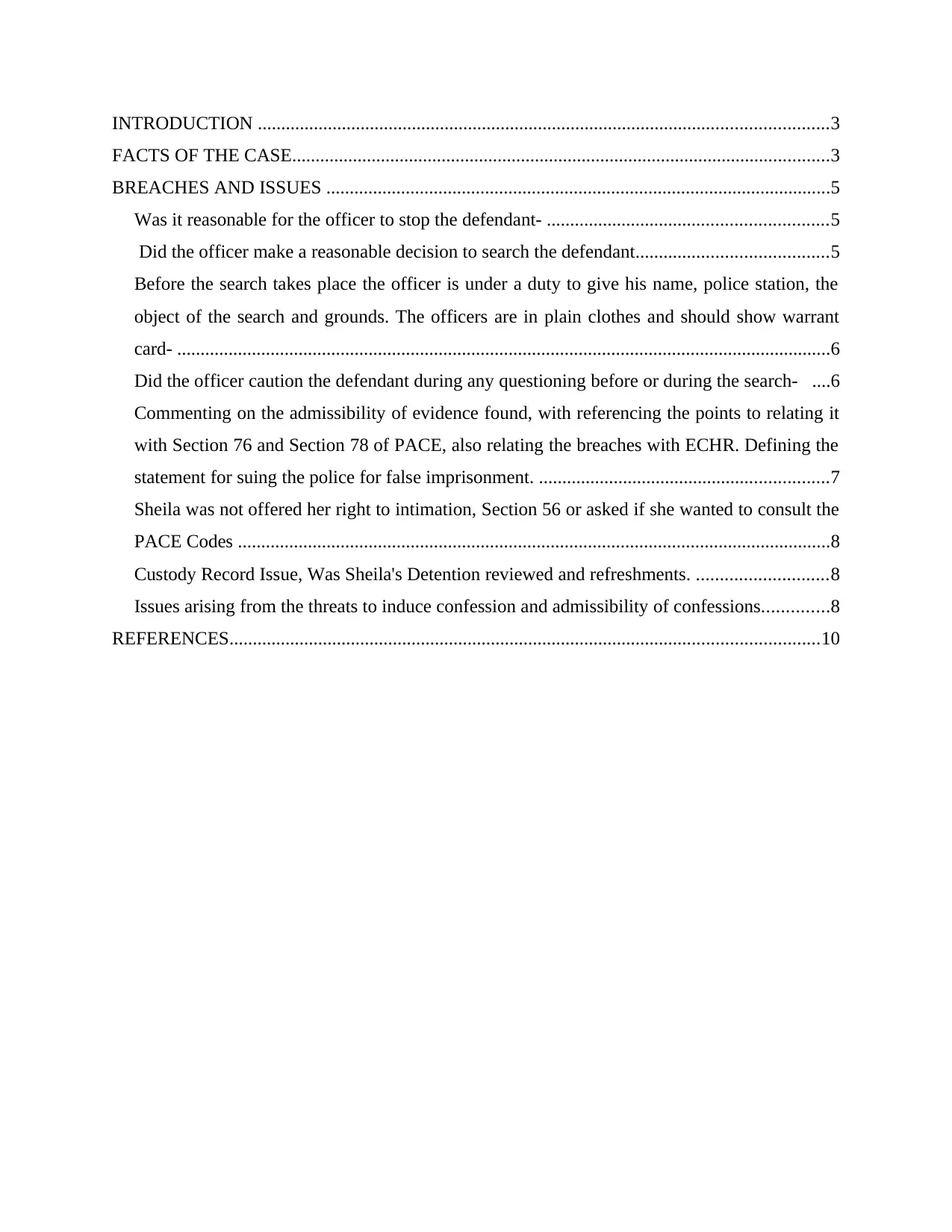
INTRODUCTION ..........................................................................................................................3
FACTS OF THE CASE...................................................................................................................3
BREACHES AND ISSUES ............................................................................................................5
Was it reasonable for the officer to stop the defendant- ............................................................5
Did the officer make a reasonable decision to search the defendant.........................................5
Before the search takes place the officer is under a duty to give his name, police station, the
object of the search and grounds. The officers are in plain clothes and should show warrant
card- ............................................................................................................................................6
Did the officer caution the defendant during any questioning before or during the search- ....6
Commenting on the admissibility of evidence found, with referencing the points to relating it
with Section 76 and Section 78 of PACE, also relating the breaches with ECHR. Defining the
statement for suing the police for false imprisonment. ..............................................................7
Sheila was not offered her right to intimation, Section 56 or asked if she wanted to consult the
PACE Codes ...............................................................................................................................8
Custody Record Issue, Was Sheila's Detention reviewed and refreshments. ............................8
Issues arising from the threats to induce confession and admissibility of confessions..............8
REFERENCES..............................................................................................................................10
FACTS OF THE CASE...................................................................................................................3
BREACHES AND ISSUES ............................................................................................................5
Was it reasonable for the officer to stop the defendant- ............................................................5
Did the officer make a reasonable decision to search the defendant.........................................5
Before the search takes place the officer is under a duty to give his name, police station, the
object of the search and grounds. The officers are in plain clothes and should show warrant
card- ............................................................................................................................................6
Did the officer caution the defendant during any questioning before or during the search- ....6
Commenting on the admissibility of evidence found, with referencing the points to relating it
with Section 76 and Section 78 of PACE, also relating the breaches with ECHR. Defining the
statement for suing the police for false imprisonment. ..............................................................7
Sheila was not offered her right to intimation, Section 56 or asked if she wanted to consult the
PACE Codes ...............................................................................................................................8
Custody Record Issue, Was Sheila's Detention reviewed and refreshments. ............................8
Issues arising from the threats to induce confession and admissibility of confessions..............8
REFERENCES..............................................................................................................................10
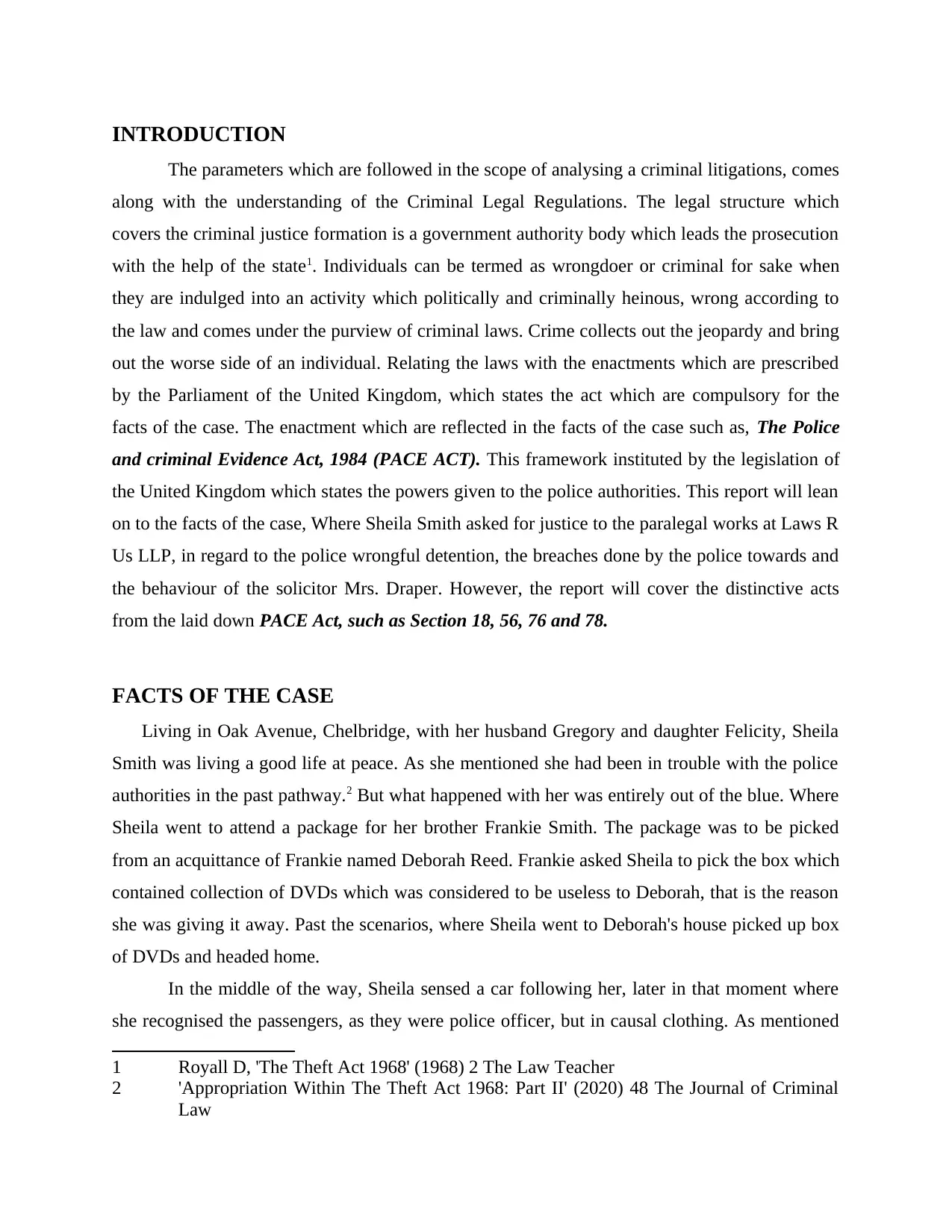
INTRODUCTION
The parameters which are followed in the scope of analysing a criminal litigations, comes
along with the understanding of the Criminal Legal Regulations. The legal structure which
covers the criminal justice formation is a government authority body which leads the prosecution
with the help of the state1. Individuals can be termed as wrongdoer or criminal for sake when
they are indulged into an activity which politically and criminally heinous, wrong according to
the law and comes under the purview of criminal laws. Crime collects out the jeopardy and bring
out the worse side of an individual. Relating the laws with the enactments which are prescribed
by the Parliament of the United Kingdom, which states the act which are compulsory for the
facts of the case. The enactment which are reflected in the facts of the case such as, The Police
and criminal Evidence Act, 1984 (PACE ACT). This framework instituted by the legislation of
the United Kingdom which states the powers given to the police authorities. This report will lean
on to the facts of the case, Where Sheila Smith asked for justice to the paralegal works at Laws R
Us LLP, in regard to the police wrongful detention, the breaches done by the police towards and
the behaviour of the solicitor Mrs. Draper. However, the report will cover the distinctive acts
from the laid down PACE Act, such as Section 18, 56, 76 and 78.
FACTS OF THE CASE
Living in Oak Avenue, Chelbridge, with her husband Gregory and daughter Felicity, Sheila
Smith was living a good life at peace. As she mentioned she had been in trouble with the police
authorities in the past pathway.2 But what happened with her was entirely out of the blue. Where
Sheila went to attend a package for her brother Frankie Smith. The package was to be picked
from an acquittance of Frankie named Deborah Reed. Frankie asked Sheila to pick the box which
contained collection of DVDs which was considered to be useless to Deborah, that is the reason
she was giving it away. Past the scenarios, where Sheila went to Deborah's house picked up box
of DVDs and headed home.
In the middle of the way, Sheila sensed a car following her, later in that moment where
she recognised the passengers, as they were police officer, but in causal clothing. As mentioned
1 Royall D, 'The Theft Act 1968' (1968) 2 The Law Teacher
2 'Appropriation Within The Theft Act 1968: Part II' (2020) 48 The Journal of Criminal
Law
The parameters which are followed in the scope of analysing a criminal litigations, comes
along with the understanding of the Criminal Legal Regulations. The legal structure which
covers the criminal justice formation is a government authority body which leads the prosecution
with the help of the state1. Individuals can be termed as wrongdoer or criminal for sake when
they are indulged into an activity which politically and criminally heinous, wrong according to
the law and comes under the purview of criminal laws. Crime collects out the jeopardy and bring
out the worse side of an individual. Relating the laws with the enactments which are prescribed
by the Parliament of the United Kingdom, which states the act which are compulsory for the
facts of the case. The enactment which are reflected in the facts of the case such as, The Police
and criminal Evidence Act, 1984 (PACE ACT). This framework instituted by the legislation of
the United Kingdom which states the powers given to the police authorities. This report will lean
on to the facts of the case, Where Sheila Smith asked for justice to the paralegal works at Laws R
Us LLP, in regard to the police wrongful detention, the breaches done by the police towards and
the behaviour of the solicitor Mrs. Draper. However, the report will cover the distinctive acts
from the laid down PACE Act, such as Section 18, 56, 76 and 78.
FACTS OF THE CASE
Living in Oak Avenue, Chelbridge, with her husband Gregory and daughter Felicity, Sheila
Smith was living a good life at peace. As she mentioned she had been in trouble with the police
authorities in the past pathway.2 But what happened with her was entirely out of the blue. Where
Sheila went to attend a package for her brother Frankie Smith. The package was to be picked
from an acquittance of Frankie named Deborah Reed. Frankie asked Sheila to pick the box which
contained collection of DVDs which was considered to be useless to Deborah, that is the reason
she was giving it away. Past the scenarios, where Sheila went to Deborah's house picked up box
of DVDs and headed home.
In the middle of the way, Sheila sensed a car following her, later in that moment where
she recognised the passengers, as they were police officer, but in causal clothing. As mentioned
1 Royall D, 'The Theft Act 1968' (1968) 2 The Law Teacher
2 'Appropriation Within The Theft Act 1968: Part II' (2020) 48 The Journal of Criminal
Law
⊘ This is a preview!⊘
Do you want full access?
Subscribe today to unlock all pages.

Trusted by 1+ million students worldwide
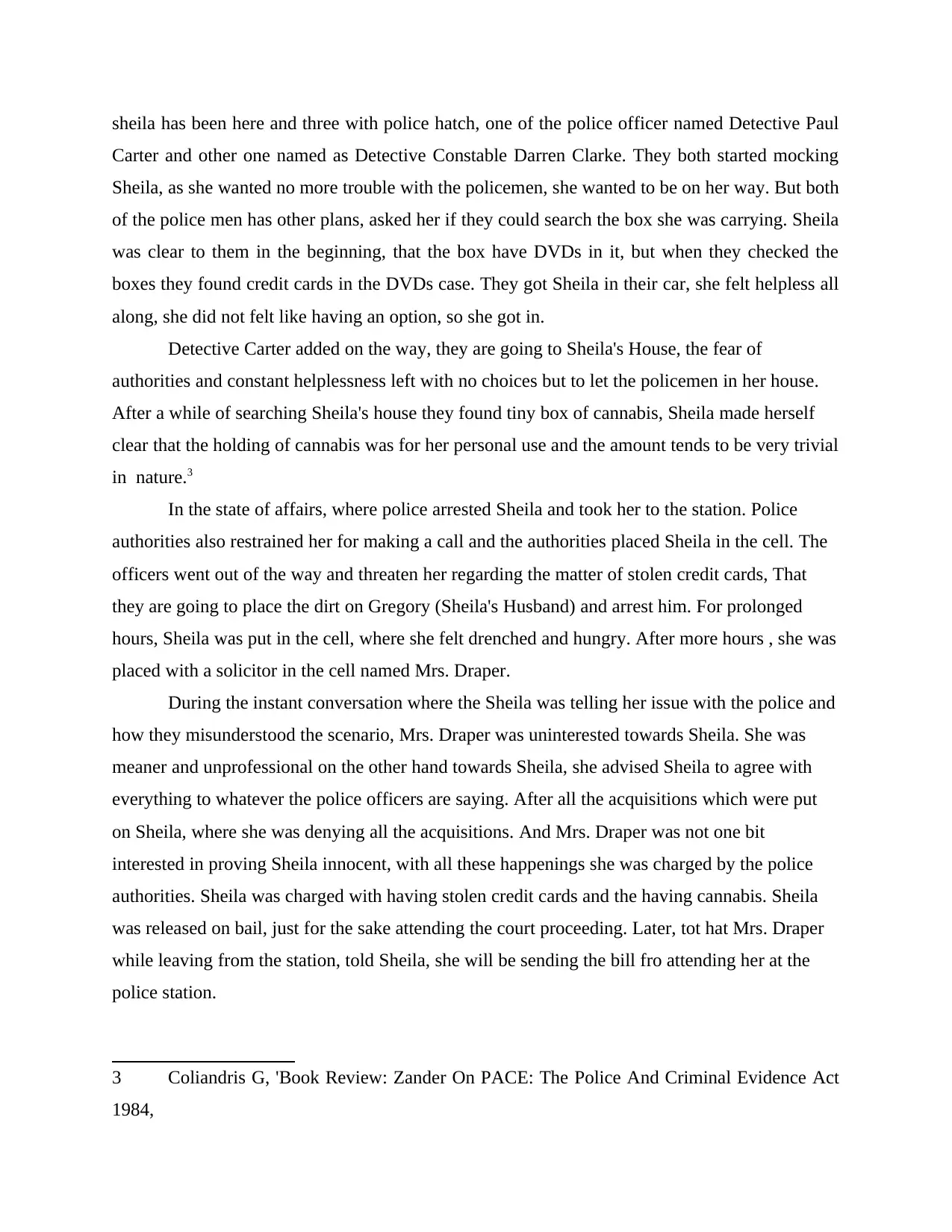
sheila has been here and three with police hatch, one of the police officer named Detective Paul
Carter and other one named as Detective Constable Darren Clarke. They both started mocking
Sheila, as she wanted no more trouble with the policemen, she wanted to be on her way. But both
of the police men has other plans, asked her if they could search the box she was carrying. Sheila
was clear to them in the beginning, that the box have DVDs in it, but when they checked the
boxes they found credit cards in the DVDs case. They got Sheila in their car, she felt helpless all
along, she did not felt like having an option, so she got in.
Detective Carter added on the way, they are going to Sheila's House, the fear of
authorities and constant helplessness left with no choices but to let the policemen in her house.
After a while of searching Sheila's house they found tiny box of cannabis, Sheila made herself
clear that the holding of cannabis was for her personal use and the amount tends to be very trivial
in nature.3
In the state of affairs, where police arrested Sheila and took her to the station. Police
authorities also restrained her for making a call and the authorities placed Sheila in the cell. The
officers went out of the way and threaten her regarding the matter of stolen credit cards, That
they are going to place the dirt on Gregory (Sheila's Husband) and arrest him. For prolonged
hours, Sheila was put in the cell, where she felt drenched and hungry. After more hours , she was
placed with a solicitor in the cell named Mrs. Draper.
During the instant conversation where the Sheila was telling her issue with the police and
how they misunderstood the scenario, Mrs. Draper was uninterested towards Sheila. She was
meaner and unprofessional on the other hand towards Sheila, she advised Sheila to agree with
everything to whatever the police officers are saying. After all the acquisitions which were put
on Sheila, where she was denying all the acquisitions. And Mrs. Draper was not one bit
interested in proving Sheila innocent, with all these happenings she was charged by the police
authorities. Sheila was charged with having stolen credit cards and the having cannabis. Sheila
was released on bail, just for the sake attending the court proceeding. Later, tot hat Mrs. Draper
while leaving from the station, told Sheila, she will be sending the bill fro attending her at the
police station.
3 Coliandris G, 'Book Review: Zander On PACE: The Police And Criminal Evidence Act
1984,
Carter and other one named as Detective Constable Darren Clarke. They both started mocking
Sheila, as she wanted no more trouble with the policemen, she wanted to be on her way. But both
of the police men has other plans, asked her if they could search the box she was carrying. Sheila
was clear to them in the beginning, that the box have DVDs in it, but when they checked the
boxes they found credit cards in the DVDs case. They got Sheila in their car, she felt helpless all
along, she did not felt like having an option, so she got in.
Detective Carter added on the way, they are going to Sheila's House, the fear of
authorities and constant helplessness left with no choices but to let the policemen in her house.
After a while of searching Sheila's house they found tiny box of cannabis, Sheila made herself
clear that the holding of cannabis was for her personal use and the amount tends to be very trivial
in nature.3
In the state of affairs, where police arrested Sheila and took her to the station. Police
authorities also restrained her for making a call and the authorities placed Sheila in the cell. The
officers went out of the way and threaten her regarding the matter of stolen credit cards, That
they are going to place the dirt on Gregory (Sheila's Husband) and arrest him. For prolonged
hours, Sheila was put in the cell, where she felt drenched and hungry. After more hours , she was
placed with a solicitor in the cell named Mrs. Draper.
During the instant conversation where the Sheila was telling her issue with the police and
how they misunderstood the scenario, Mrs. Draper was uninterested towards Sheila. She was
meaner and unprofessional on the other hand towards Sheila, she advised Sheila to agree with
everything to whatever the police officers are saying. After all the acquisitions which were put
on Sheila, where she was denying all the acquisitions. And Mrs. Draper was not one bit
interested in proving Sheila innocent, with all these happenings she was charged by the police
authorities. Sheila was charged with having stolen credit cards and the having cannabis. Sheila
was released on bail, just for the sake attending the court proceeding. Later, tot hat Mrs. Draper
while leaving from the station, told Sheila, she will be sending the bill fro attending her at the
police station.
3 Coliandris G, 'Book Review: Zander On PACE: The Police And Criminal Evidence Act
1984,
Paraphrase This Document
Need a fresh take? Get an instant paraphrase of this document with our AI Paraphraser
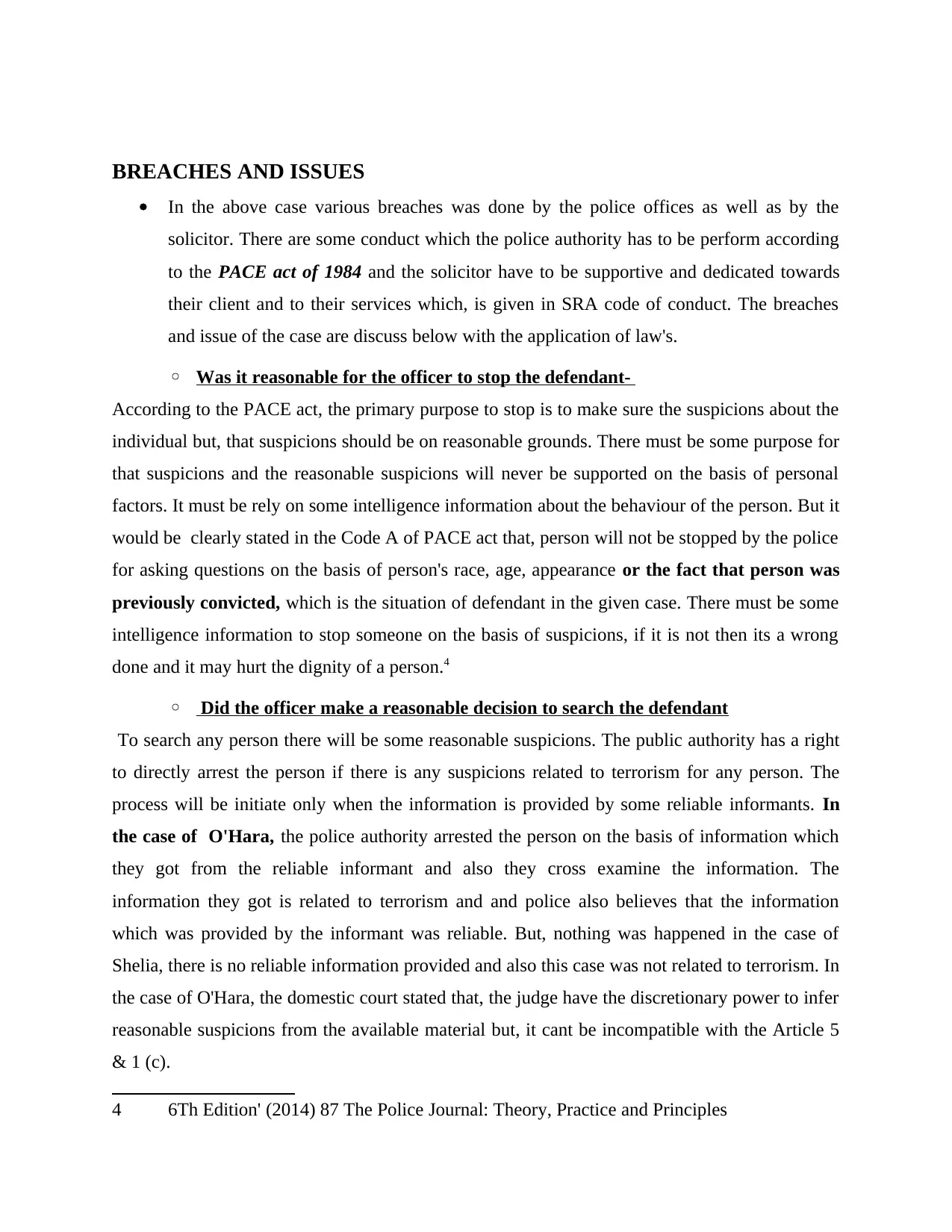
BREACHES AND ISSUES
In the above case various breaches was done by the police offices as well as by the
solicitor. There are some conduct which the police authority has to be perform according
to the PACE act of 1984 and the solicitor have to be supportive and dedicated towards
their client and to their services which, is given in SRA code of conduct. The breaches
and issue of the case are discuss below with the application of law's.
◦ Was it reasonable for the officer to stop the defendant-
According to the PACE act, the primary purpose to stop is to make sure the suspicions about the
individual but, that suspicions should be on reasonable grounds. There must be some purpose for
that suspicions and the reasonable suspicions will never be supported on the basis of personal
factors. It must be rely on some intelligence information about the behaviour of the person. But it
would be clearly stated in the Code A of PACE act that, person will not be stopped by the police
for asking questions on the basis of person's race, age, appearance or the fact that person was
previously convicted, which is the situation of defendant in the given case. There must be some
intelligence information to stop someone on the basis of suspicions, if it is not then its a wrong
done and it may hurt the dignity of a person.4
◦ Did the officer make a reasonable decision to search the defendant
To search any person there will be some reasonable suspicions. The public authority has a right
to directly arrest the person if there is any suspicions related to terrorism for any person. The
process will be initiate only when the information is provided by some reliable informants. In
the case of O'Hara, the police authority arrested the person on the basis of information which
they got from the reliable informant and also they cross examine the information. The
information they got is related to terrorism and and police also believes that the information
which was provided by the informant was reliable. But, nothing was happened in the case of
Shelia, there is no reliable information provided and also this case was not related to terrorism. In
the case of O'Hara, the domestic court stated that, the judge have the discretionary power to infer
reasonable suspicions from the available material but, it cant be incompatible with the Article 5
& 1 (c).
4 6Th Edition' (2014) 87 The Police Journal: Theory, Practice and Principles
In the above case various breaches was done by the police offices as well as by the
solicitor. There are some conduct which the police authority has to be perform according
to the PACE act of 1984 and the solicitor have to be supportive and dedicated towards
their client and to their services which, is given in SRA code of conduct. The breaches
and issue of the case are discuss below with the application of law's.
◦ Was it reasonable for the officer to stop the defendant-
According to the PACE act, the primary purpose to stop is to make sure the suspicions about the
individual but, that suspicions should be on reasonable grounds. There must be some purpose for
that suspicions and the reasonable suspicions will never be supported on the basis of personal
factors. It must be rely on some intelligence information about the behaviour of the person. But it
would be clearly stated in the Code A of PACE act that, person will not be stopped by the police
for asking questions on the basis of person's race, age, appearance or the fact that person was
previously convicted, which is the situation of defendant in the given case. There must be some
intelligence information to stop someone on the basis of suspicions, if it is not then its a wrong
done and it may hurt the dignity of a person.4
◦ Did the officer make a reasonable decision to search the defendant
To search any person there will be some reasonable suspicions. The public authority has a right
to directly arrest the person if there is any suspicions related to terrorism for any person. The
process will be initiate only when the information is provided by some reliable informants. In
the case of O'Hara, the police authority arrested the person on the basis of information which
they got from the reliable informant and also they cross examine the information. The
information they got is related to terrorism and and police also believes that the information
which was provided by the informant was reliable. But, nothing was happened in the case of
Shelia, there is no reliable information provided and also this case was not related to terrorism. In
the case of O'Hara, the domestic court stated that, the judge have the discretionary power to infer
reasonable suspicions from the available material but, it cant be incompatible with the Article 5
& 1 (c).
4 6Th Edition' (2014) 87 The Police Journal: Theory, Practice and Principles
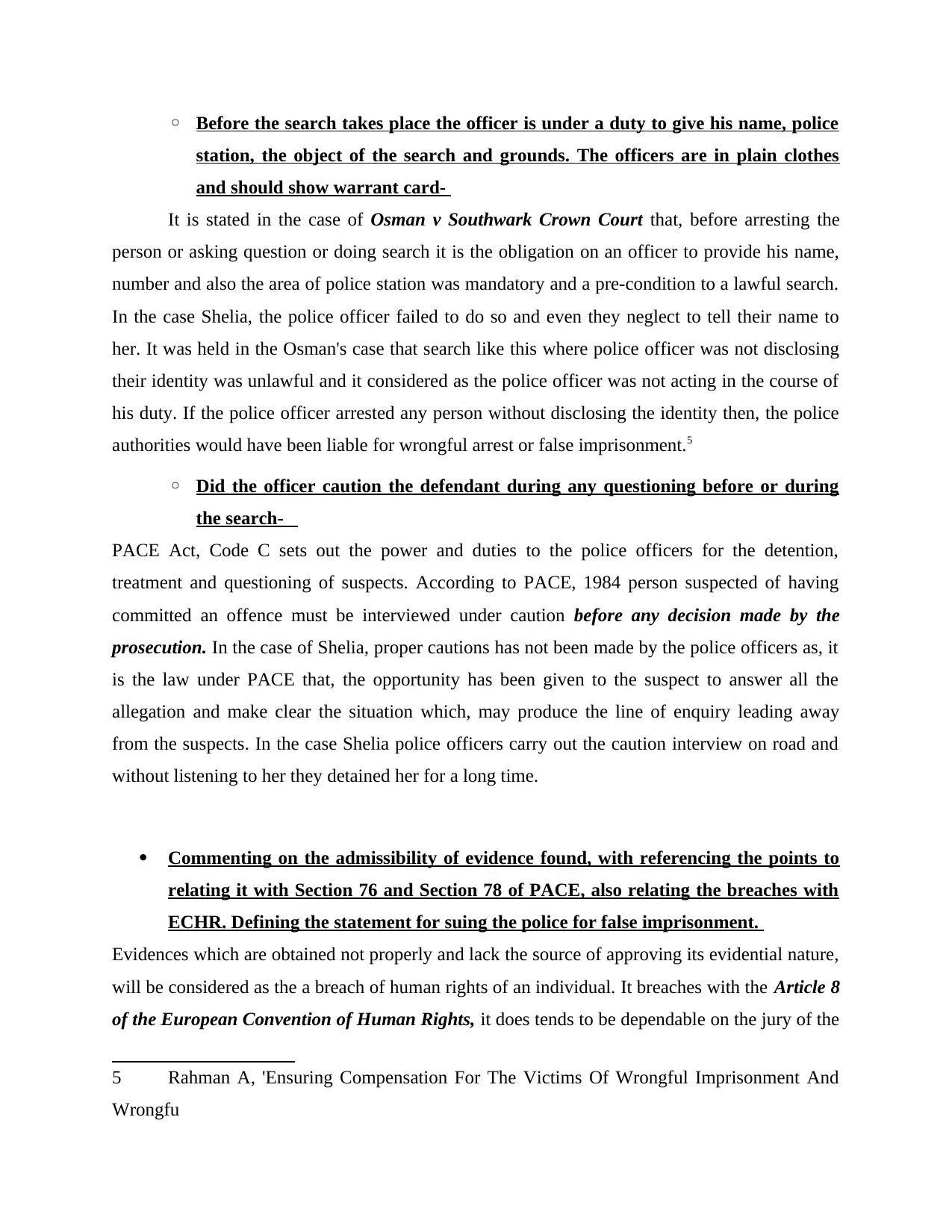
◦ Before the search takes place the officer is under a duty to give his name, police
station, the object of the search and grounds. The officers are in plain clothes
and should show warrant card-
It is stated in the case of Osman v Southwark Crown Court that, before arresting the
person or asking question or doing search it is the obligation on an officer to provide his name,
number and also the area of police station was mandatory and a pre-condition to a lawful search.
In the case Shelia, the police officer failed to do so and even they neglect to tell their name to
her. It was held in the Osman's case that search like this where police officer was not disclosing
their identity was unlawful and it considered as the police officer was not acting in the course of
his duty. If the police officer arrested any person without disclosing the identity then, the police
authorities would have been liable for wrongful arrest or false imprisonment.5
◦ Did the officer caution the defendant during any questioning before or during
the search-
PACE Act, Code C sets out the power and duties to the police officers for the detention,
treatment and questioning of suspects. According to PACE, 1984 person suspected of having
committed an offence must be interviewed under caution before any decision made by the
prosecution. In the case of Shelia, proper cautions has not been made by the police officers as, it
is the law under PACE that, the opportunity has been given to the suspect to answer all the
allegation and make clear the situation which, may produce the line of enquiry leading away
from the suspects. In the case Shelia police officers carry out the caution interview on road and
without listening to her they detained her for a long time.
Commenting on the admissibility of evidence found, with referencing the points to
relating it with Section 76 and Section 78 of PACE, also relating the breaches with
ECHR. Defining the statement for suing the police for false imprisonment.
Evidences which are obtained not properly and lack the source of approving its evidential nature,
will be considered as the a breach of human rights of an individual. It breaches with the Article 8
of the European Convention of Human Rights, it does tends to be dependable on the jury of the
5 Rahman A, 'Ensuring Compensation For The Victims Of Wrongful Imprisonment And
Wrongfu
station, the object of the search and grounds. The officers are in plain clothes
and should show warrant card-
It is stated in the case of Osman v Southwark Crown Court that, before arresting the
person or asking question or doing search it is the obligation on an officer to provide his name,
number and also the area of police station was mandatory and a pre-condition to a lawful search.
In the case Shelia, the police officer failed to do so and even they neglect to tell their name to
her. It was held in the Osman's case that search like this where police officer was not disclosing
their identity was unlawful and it considered as the police officer was not acting in the course of
his duty. If the police officer arrested any person without disclosing the identity then, the police
authorities would have been liable for wrongful arrest or false imprisonment.5
◦ Did the officer caution the defendant during any questioning before or during
the search-
PACE Act, Code C sets out the power and duties to the police officers for the detention,
treatment and questioning of suspects. According to PACE, 1984 person suspected of having
committed an offence must be interviewed under caution before any decision made by the
prosecution. In the case of Shelia, proper cautions has not been made by the police officers as, it
is the law under PACE that, the opportunity has been given to the suspect to answer all the
allegation and make clear the situation which, may produce the line of enquiry leading away
from the suspects. In the case Shelia police officers carry out the caution interview on road and
without listening to her they detained her for a long time.
Commenting on the admissibility of evidence found, with referencing the points to
relating it with Section 76 and Section 78 of PACE, also relating the breaches with
ECHR. Defining the statement for suing the police for false imprisonment.
Evidences which are obtained not properly and lack the source of approving its evidential nature,
will be considered as the a breach of human rights of an individual. It breaches with the Article 8
of the European Convention of Human Rights, it does tends to be dependable on the jury of the
5 Rahman A, 'Ensuring Compensation For The Victims Of Wrongful Imprisonment And
Wrongfu
⊘ This is a preview!⊘
Do you want full access?
Subscribe today to unlock all pages.

Trusted by 1+ million students worldwide
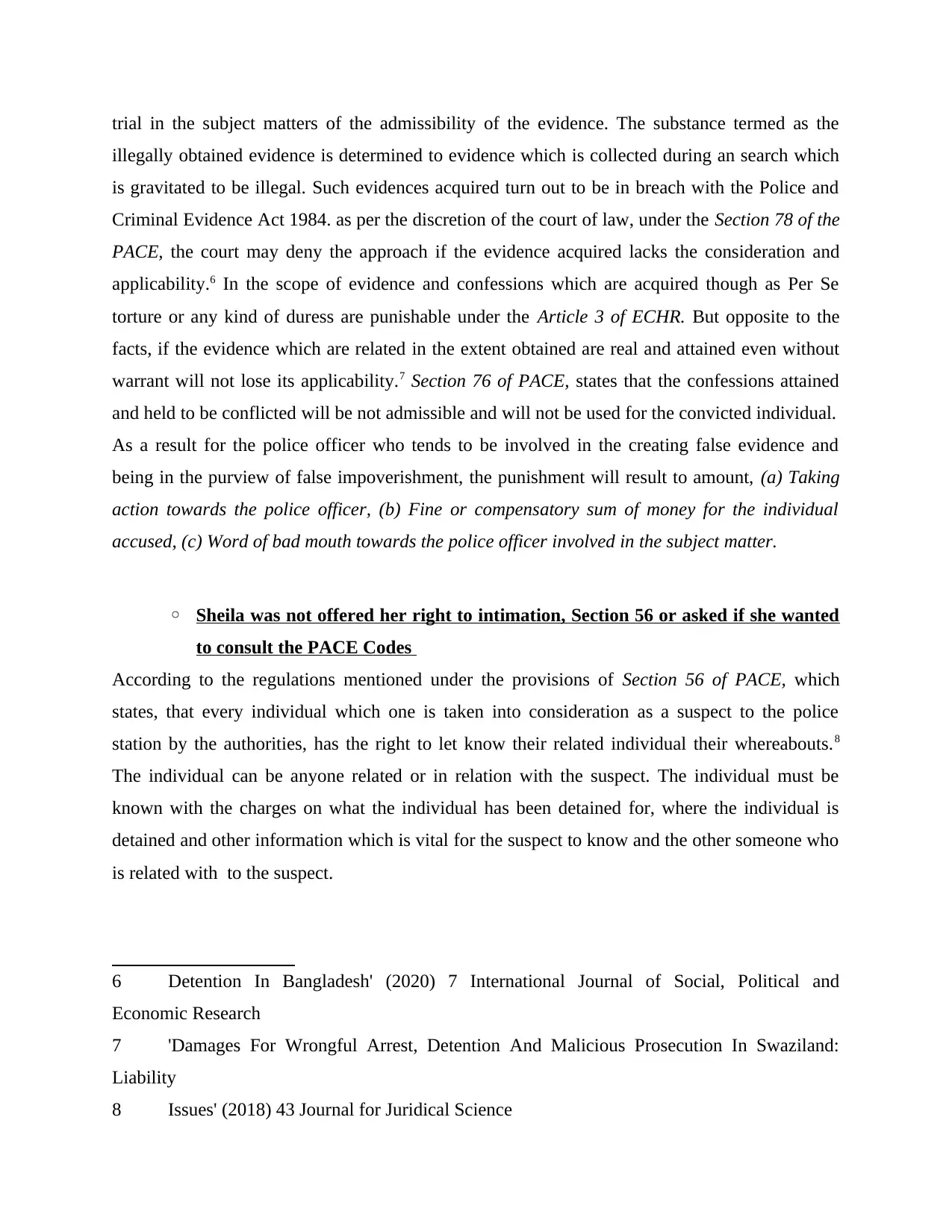
trial in the subject matters of the admissibility of the evidence. The substance termed as the
illegally obtained evidence is determined to evidence which is collected during an search which
is gravitated to be illegal. Such evidences acquired turn out to be in breach with the Police and
Criminal Evidence Act 1984. as per the discretion of the court of law, under the Section 78 of the
PACE, the court may deny the approach if the evidence acquired lacks the consideration and
applicability.6 In the scope of evidence and confessions which are acquired though as Per Se
torture or any kind of duress are punishable under the Article 3 of ECHR. But opposite to the
facts, if the evidence which are related in the extent obtained are real and attained even without
warrant will not lose its applicability.7 Section 76 of PACE, states that the confessions attained
and held to be conflicted will be not admissible and will not be used for the convicted individual.
As a result for the police officer who tends to be involved in the creating false evidence and
being in the purview of false impoverishment, the punishment will result to amount, (a) Taking
action towards the police officer, (b) Fine or compensatory sum of money for the individual
accused, (c) Word of bad mouth towards the police officer involved in the subject matter.
◦ Sheila was not offered her right to intimation, Section 56 or asked if she wanted
to consult the PACE Codes
According to the regulations mentioned under the provisions of Section 56 of PACE, which
states, that every individual which one is taken into consideration as a suspect to the police
station by the authorities, has the right to let know their related individual their whereabouts.8
The individual can be anyone related or in relation with the suspect. The individual must be
known with the charges on what the individual has been detained for, where the individual is
detained and other information which is vital for the suspect to know and the other someone who
is related with to the suspect.
6 Detention In Bangladesh' (2020) 7 International Journal of Social, Political and
Economic Research
7 'Damages For Wrongful Arrest, Detention And Malicious Prosecution In Swaziland:
Liability
8 Issues' (2018) 43 Journal for Juridical Science
illegally obtained evidence is determined to evidence which is collected during an search which
is gravitated to be illegal. Such evidences acquired turn out to be in breach with the Police and
Criminal Evidence Act 1984. as per the discretion of the court of law, under the Section 78 of the
PACE, the court may deny the approach if the evidence acquired lacks the consideration and
applicability.6 In the scope of evidence and confessions which are acquired though as Per Se
torture or any kind of duress are punishable under the Article 3 of ECHR. But opposite to the
facts, if the evidence which are related in the extent obtained are real and attained even without
warrant will not lose its applicability.7 Section 76 of PACE, states that the confessions attained
and held to be conflicted will be not admissible and will not be used for the convicted individual.
As a result for the police officer who tends to be involved in the creating false evidence and
being in the purview of false impoverishment, the punishment will result to amount, (a) Taking
action towards the police officer, (b) Fine or compensatory sum of money for the individual
accused, (c) Word of bad mouth towards the police officer involved in the subject matter.
◦ Sheila was not offered her right to intimation, Section 56 or asked if she wanted
to consult the PACE Codes
According to the regulations mentioned under the provisions of Section 56 of PACE, which
states, that every individual which one is taken into consideration as a suspect to the police
station by the authorities, has the right to let know their related individual their whereabouts.8
The individual can be anyone related or in relation with the suspect. The individual must be
known with the charges on what the individual has been detained for, where the individual is
detained and other information which is vital for the suspect to know and the other someone who
is related with to the suspect.
6 Detention In Bangladesh' (2020) 7 International Journal of Social, Political and
Economic Research
7 'Damages For Wrongful Arrest, Detention And Malicious Prosecution In Swaziland:
Liability
8 Issues' (2018) 43 Journal for Juridical Science
Paraphrase This Document
Need a fresh take? Get an instant paraphrase of this document with our AI Paraphraser
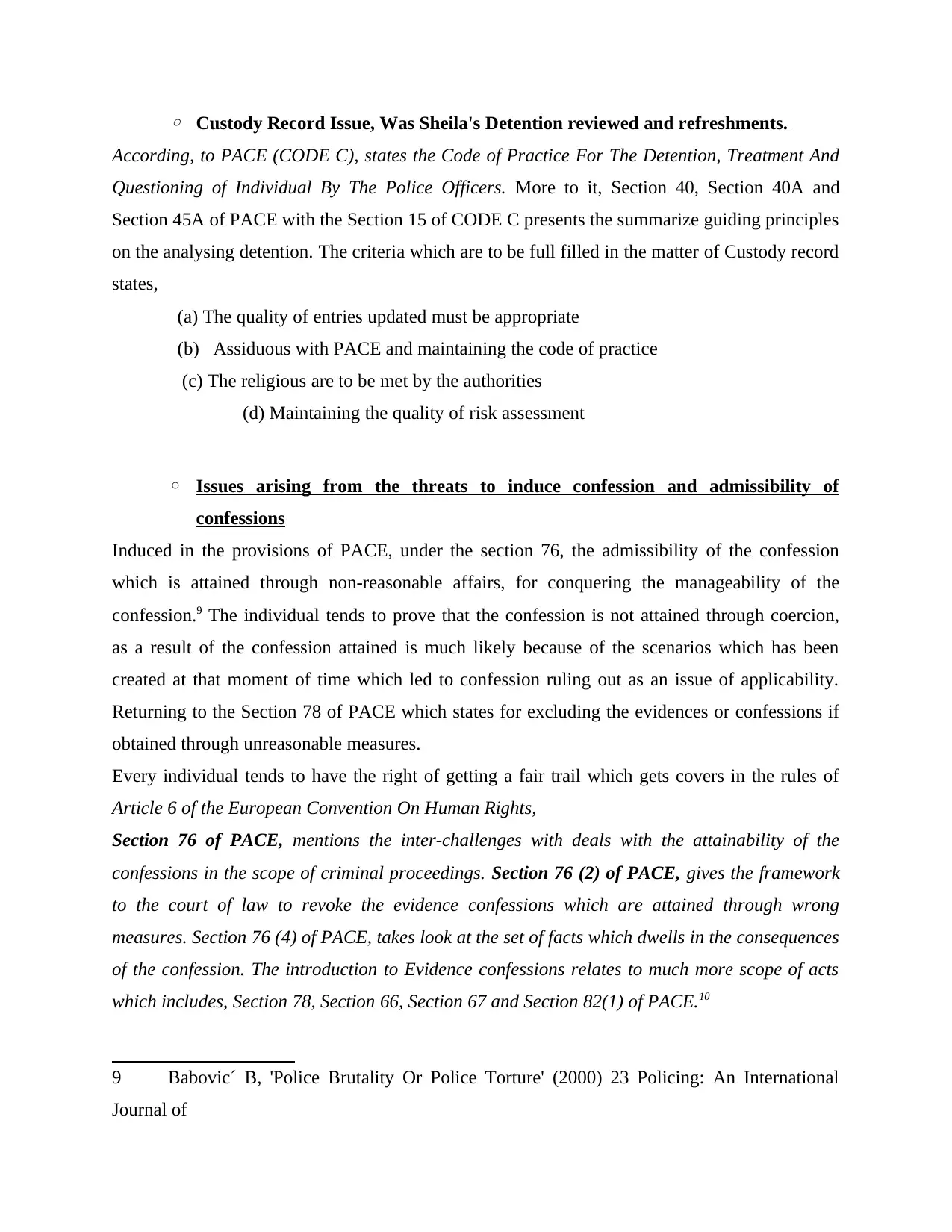
◦ Custody Record Issue, Was Sheila's Detention reviewed and refreshments.
According, to PACE (CODE C), states the Code of Practice For The Detention, Treatment And
Questioning of Individual By The Police Officers. More to it, Section 40, Section 40A and
Section 45A of PACE with the Section 15 of CODE C presents the summarize guiding principles
on the analysing detention. The criteria which are to be full filled in the matter of Custody record
states,
(a) The quality of entries updated must be appropriate
(b) Assiduous with PACE and maintaining the code of practice
(c) The religious are to be met by the authorities
(d) Maintaining the quality of risk assessment
◦ Issues arising from the threats to induce confession and admissibility of
confessions
Induced in the provisions of PACE, under the section 76, the admissibility of the confession
which is attained through non-reasonable affairs, for conquering the manageability of the
confession.9 The individual tends to prove that the confession is not attained through coercion,
as a result of the confession attained is much likely because of the scenarios which has been
created at that moment of time which led to confession ruling out as an issue of applicability.
Returning to the Section 78 of PACE which states for excluding the evidences or confessions if
obtained through unreasonable measures.
Every individual tends to have the right of getting a fair trail which gets covers in the rules of
Article 6 of the European Convention On Human Rights,
Section 76 of PACE, mentions the inter-challenges with deals with the attainability of the
confessions in the scope of criminal proceedings. Section 76 (2) of PACE, gives the framework
to the court of law to revoke the evidence confessions which are attained through wrong
measures. Section 76 (4) of PACE, takes look at the set of facts which dwells in the consequences
of the confession. The introduction to Evidence confessions relates to much more scope of acts
which includes, Section 78, Section 66, Section 67 and Section 82(1) of PACE.10
9 Babovic´ B, 'Police Brutality Or Police Torture' (2000) 23 Policing: An International
Journal of
According, to PACE (CODE C), states the Code of Practice For The Detention, Treatment And
Questioning of Individual By The Police Officers. More to it, Section 40, Section 40A and
Section 45A of PACE with the Section 15 of CODE C presents the summarize guiding principles
on the analysing detention. The criteria which are to be full filled in the matter of Custody record
states,
(a) The quality of entries updated must be appropriate
(b) Assiduous with PACE and maintaining the code of practice
(c) The religious are to be met by the authorities
(d) Maintaining the quality of risk assessment
◦ Issues arising from the threats to induce confession and admissibility of
confessions
Induced in the provisions of PACE, under the section 76, the admissibility of the confession
which is attained through non-reasonable affairs, for conquering the manageability of the
confession.9 The individual tends to prove that the confession is not attained through coercion,
as a result of the confession attained is much likely because of the scenarios which has been
created at that moment of time which led to confession ruling out as an issue of applicability.
Returning to the Section 78 of PACE which states for excluding the evidences or confessions if
obtained through unreasonable measures.
Every individual tends to have the right of getting a fair trail which gets covers in the rules of
Article 6 of the European Convention On Human Rights,
Section 76 of PACE, mentions the inter-challenges with deals with the attainability of the
confessions in the scope of criminal proceedings. Section 76 (2) of PACE, gives the framework
to the court of law to revoke the evidence confessions which are attained through wrong
measures. Section 76 (4) of PACE, takes look at the set of facts which dwells in the consequences
of the confession. The introduction to Evidence confessions relates to much more scope of acts
which includes, Section 78, Section 66, Section 67 and Section 82(1) of PACE.10
9 Babovic´ B, 'Police Brutality Or Police Torture' (2000) 23 Policing: An International
Journal of
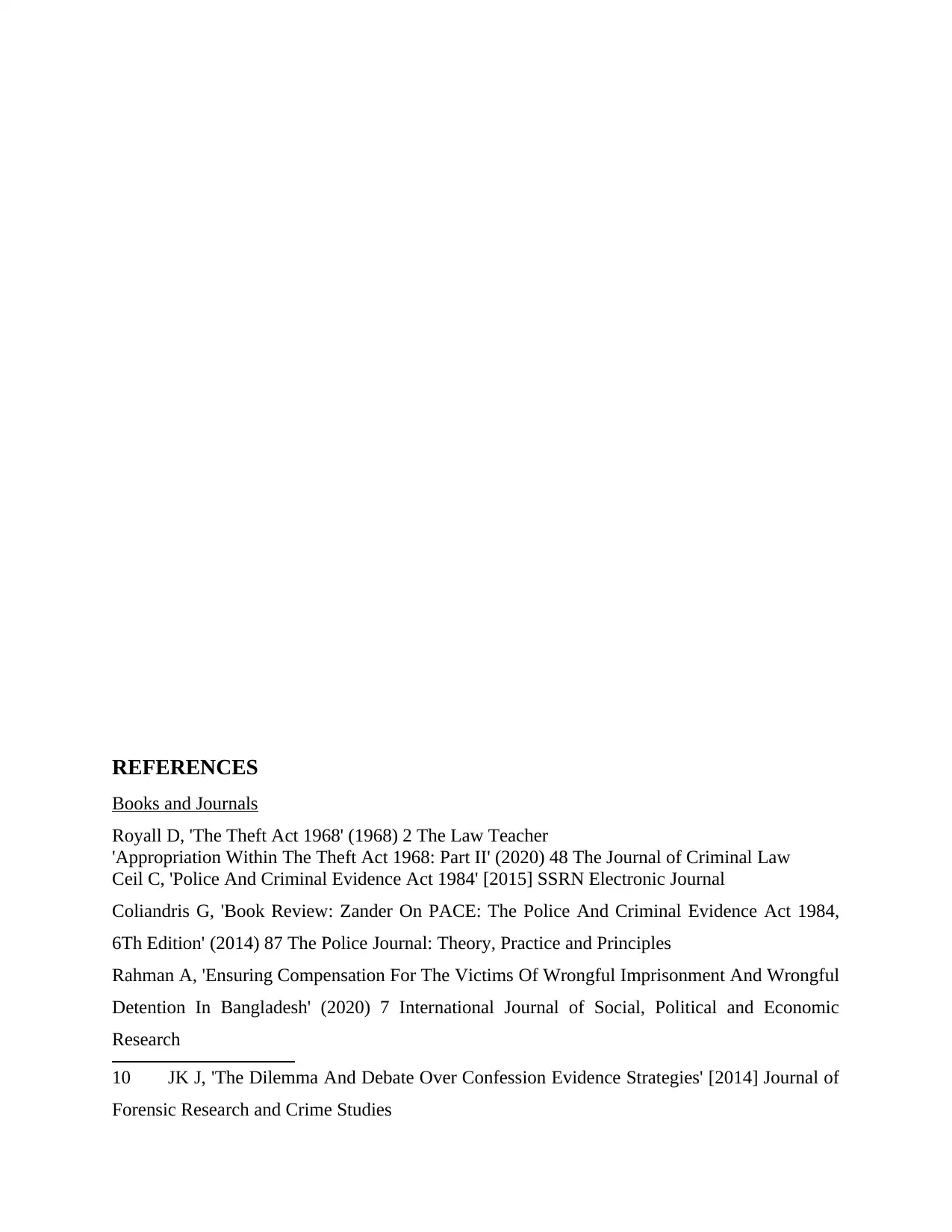
REFERENCES
Books and Journals
Royall D, 'The Theft Act 1968' (1968) 2 The Law Teacher
'Appropriation Within The Theft Act 1968: Part II' (2020) 48 The Journal of Criminal Law
Ceil C, 'Police And Criminal Evidence Act 1984' [2015] SSRN Electronic Journal
Coliandris G, 'Book Review: Zander On PACE: The Police And Criminal Evidence Act 1984,
6Th Edition' (2014) 87 The Police Journal: Theory, Practice and Principles
Rahman A, 'Ensuring Compensation For The Victims Of Wrongful Imprisonment And Wrongful
Detention In Bangladesh' (2020) 7 International Journal of Social, Political and Economic
Research
10 JK J, 'The Dilemma And Debate Over Confession Evidence Strategies' [2014] Journal of
Forensic Research and Crime Studies
Books and Journals
Royall D, 'The Theft Act 1968' (1968) 2 The Law Teacher
'Appropriation Within The Theft Act 1968: Part II' (2020) 48 The Journal of Criminal Law
Ceil C, 'Police And Criminal Evidence Act 1984' [2015] SSRN Electronic Journal
Coliandris G, 'Book Review: Zander On PACE: The Police And Criminal Evidence Act 1984,
6Th Edition' (2014) 87 The Police Journal: Theory, Practice and Principles
Rahman A, 'Ensuring Compensation For The Victims Of Wrongful Imprisonment And Wrongful
Detention In Bangladesh' (2020) 7 International Journal of Social, Political and Economic
Research
10 JK J, 'The Dilemma And Debate Over Confession Evidence Strategies' [2014] Journal of
Forensic Research and Crime Studies
⊘ This is a preview!⊘
Do you want full access?
Subscribe today to unlock all pages.

Trusted by 1+ million students worldwide
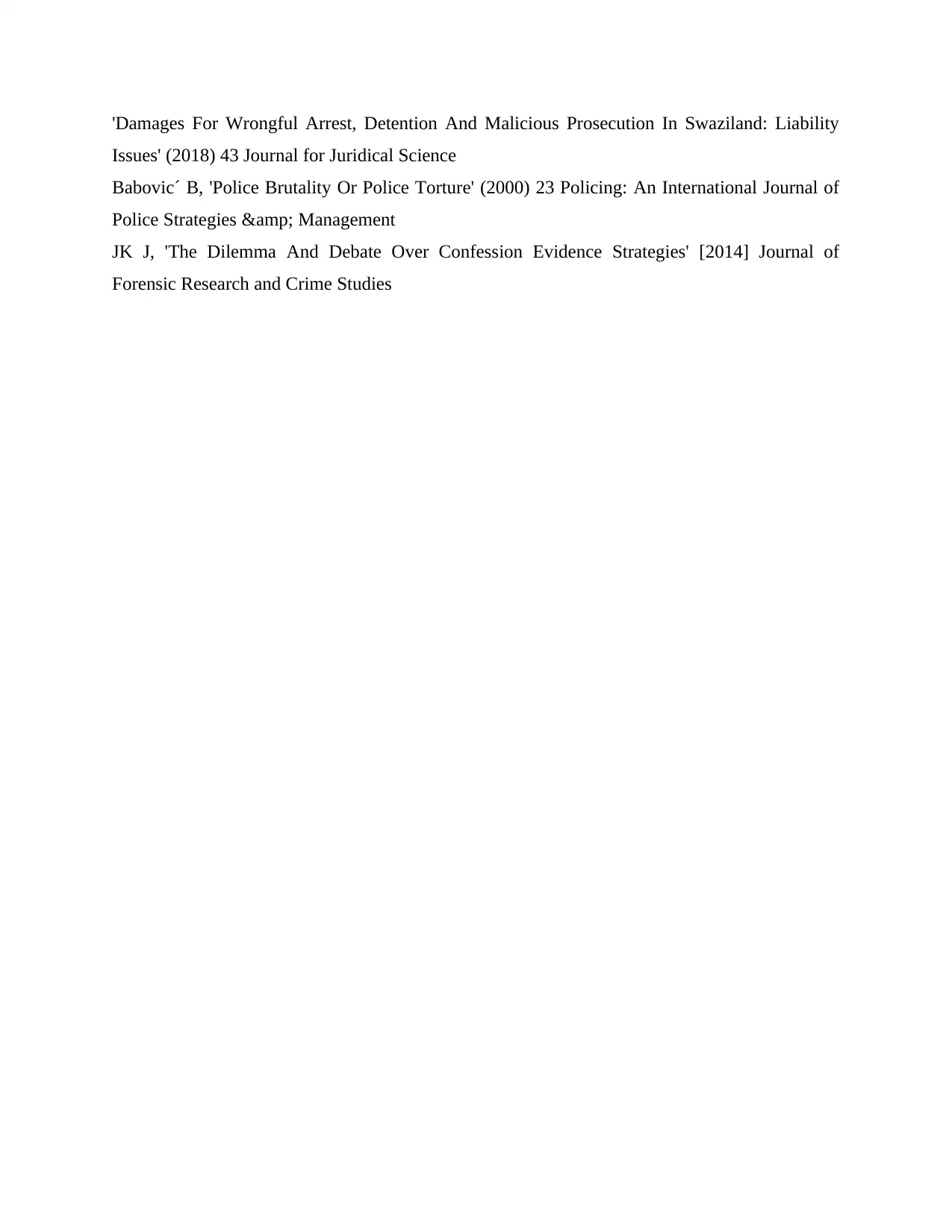
'Damages For Wrongful Arrest, Detention And Malicious Prosecution In Swaziland: Liability
Issues' (2018) 43 Journal for Juridical Science
Babovic´ B, 'Police Brutality Or Police Torture' (2000) 23 Policing: An International Journal of
Police Strategies & Management
JK J, 'The Dilemma And Debate Over Confession Evidence Strategies' [2014] Journal of
Forensic Research and Crime Studies
Issues' (2018) 43 Journal for Juridical Science
Babovic´ B, 'Police Brutality Or Police Torture' (2000) 23 Policing: An International Journal of
Police Strategies & Management
JK J, 'The Dilemma And Debate Over Confession Evidence Strategies' [2014] Journal of
Forensic Research and Crime Studies
1 out of 10
Related Documents
Your All-in-One AI-Powered Toolkit for Academic Success.
+13062052269
info@desklib.com
Available 24*7 on WhatsApp / Email
![[object Object]](/_next/static/media/star-bottom.7253800d.svg)
Unlock your academic potential
Copyright © 2020–2025 A2Z Services. All Rights Reserved. Developed and managed by ZUCOL.




![University Law Case Study: R vs. Smith [2003] QCA 76](/_next/image/?url=https%3A%2F%2Fdesklib.com%2Fmedia%2Fimages%2Fci%2F394dee3982ef454f9e4a28ed0b06d045.jpg&w=256&q=75)
